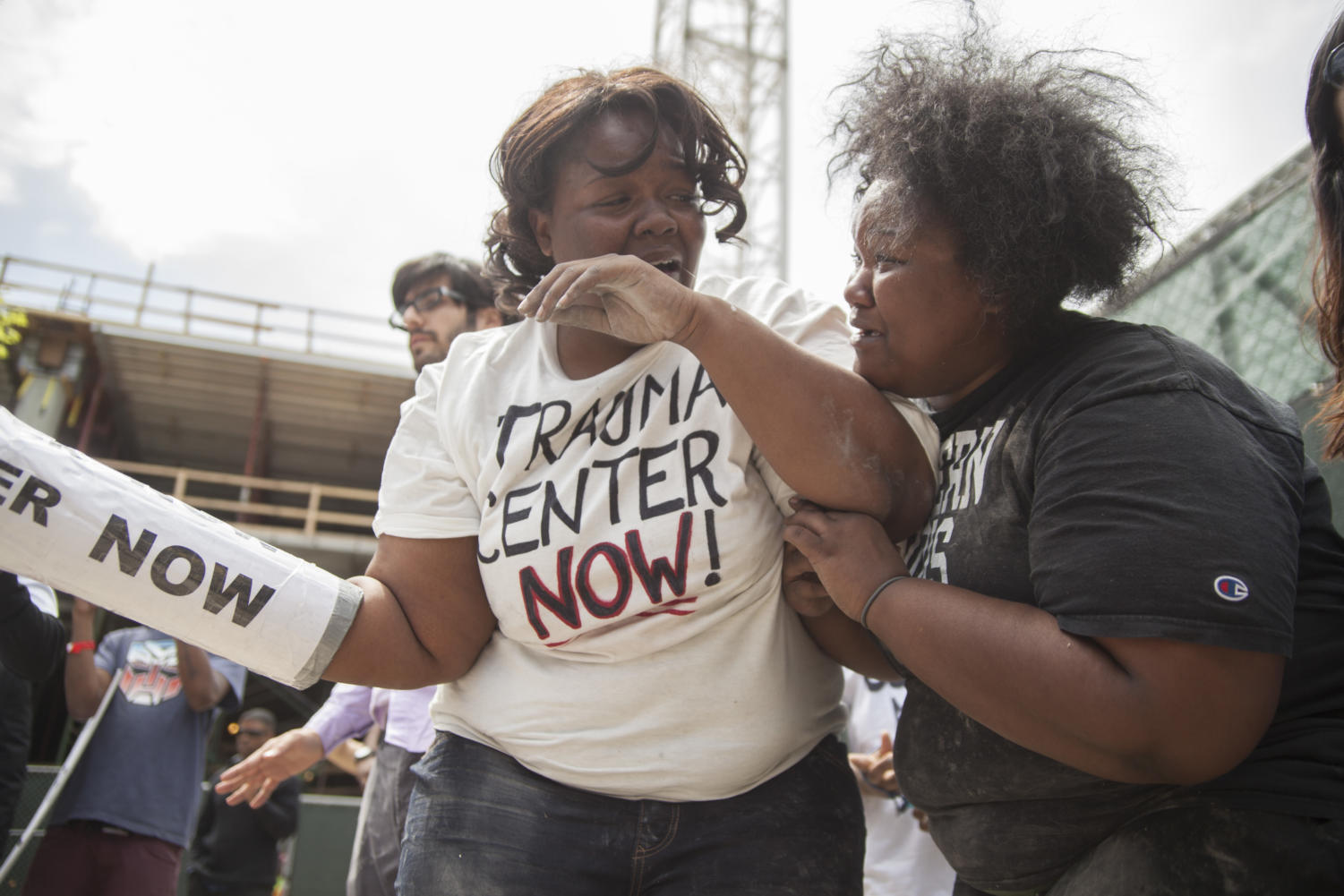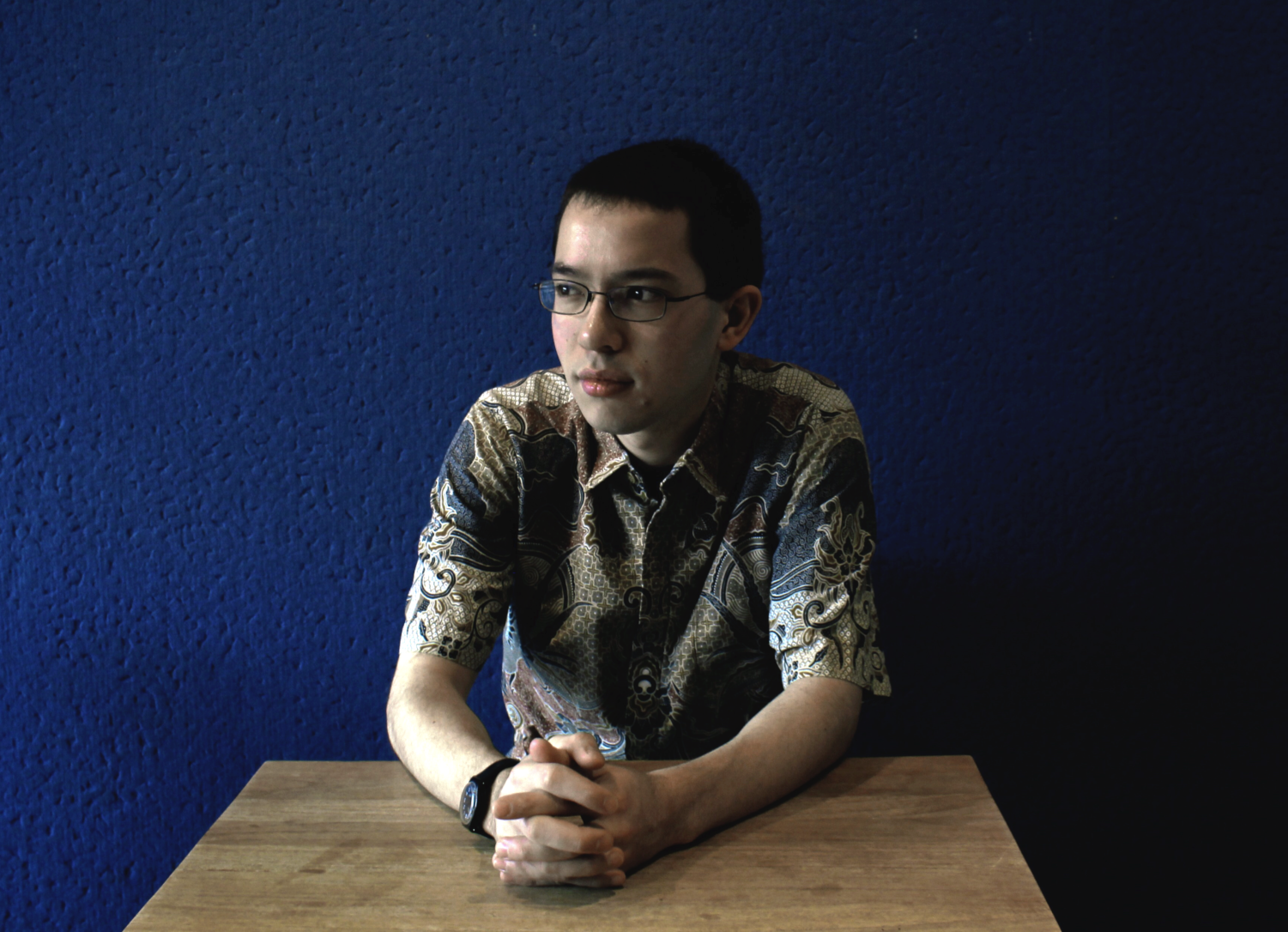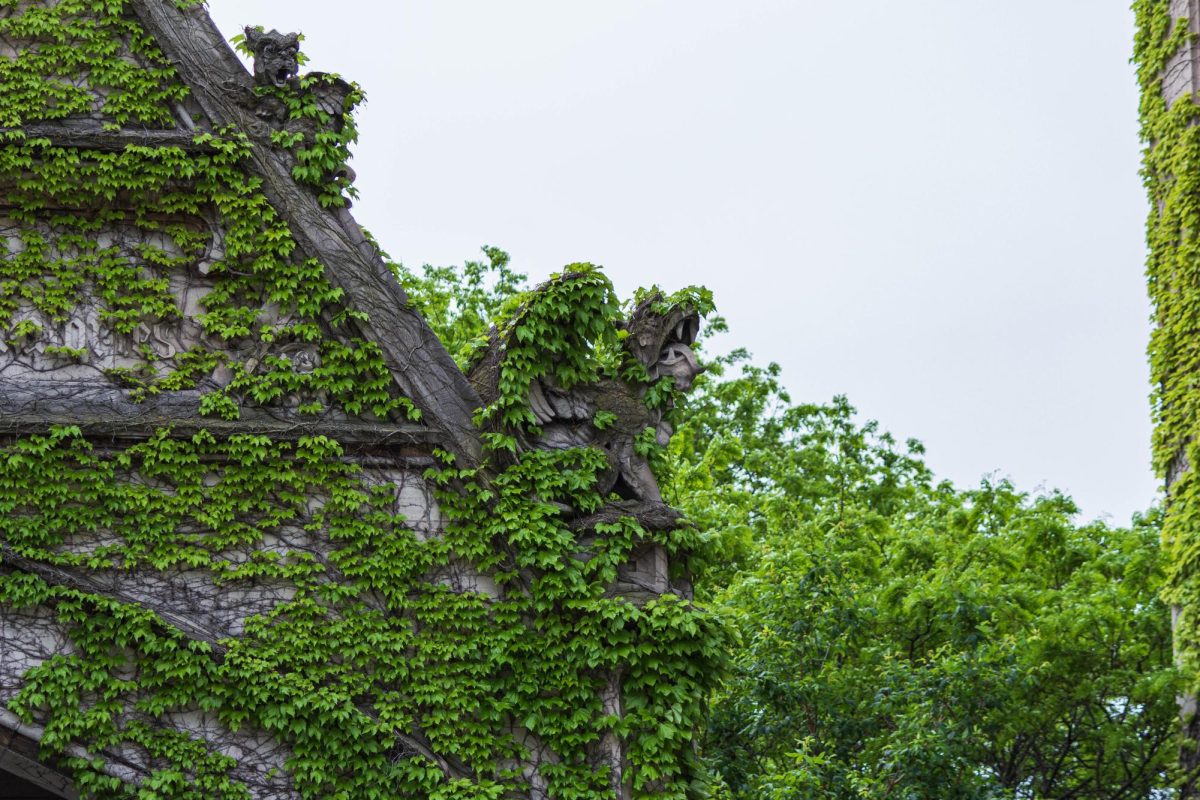The University’s Level I adult trauma center, which will open on campus on Tuesday, was officially announced on December 17, 2015, but its history precedes the announcement by several years.
In some ways, that final announcement in 2015 heralded the end of an era, though the community and campus activists who had agitated for it for years—since August 2010—might deny that characterization.
Work remains to be done even now, as the trauma center is poised to open, stressed Darrius Lightfoot, cofounder of Fearless Leading by the Youth (FLY) and an early agitator for a trauma center on the South Side.
“Folks aren’t going to stop getting shot,” he told The Maroon.
Even so, the announcement marked a monumental shift in a campaign that was long marked by intense administrative resistance, campus controversy, and widespread media attention. The trauma center activists were featured in a 2011 issue of The New York Times, for example, that lumped them under the umbrella of nationwide Occupy protests.
Over the years, the Trauma Care Coalition (TCC) grew to include Southside Together Organizing for Power (STOP) and its youth affiliate, FLY; Kenwood Oakland Community Organization (KOCO); the Jewish Council on Urban Affairs (JCUA); National Nurses United; Students for Health Equity (SHE), a University student group; and the Prayer and Action Collective (PAC), formerly Trauma Center Prayers.
The campaign’s beginning, however, was personal. The first cries for a trauma center to be reinstated at the University came from the family and friends of 18-year-old Damian Turner, a cofounder of FLY who was killed on August 15, 2010.
The Beginning
FLY initially formed in 2007 as a temporary after-school and summer program for youth run by STOP, according to Lightfoot, who said he was already active with STOP as a 15-year-old living in Woodlawn. After the program reached its scheduled end date, Lightfoot said he and a group of others, including Turner, decided to continue FLY but refocus it as an activist youth wing of STOP.
Health care on the South Side was “a big focus” of group discussion, Lightfoot said, but trauma care did not emerge as a specific concern until after Turner was shot on 61st Street and Cottage Grove Avenue on August 15, 2010.
Four days later, 25 youth activists held a meeting to discuss their outrage at Turner’s death, which occurred during a 27-minute ambulance ride to Northwestern Memorial Hospital.
“Someone asked, ‘why was he taken so far?’ And that led to research,” Lightfoot said.
The children’s trauma center at UChicago Medicine (UCM) treated only children 16 years and younger, they learned; UCM had not offered adult trauma care since 1988. No Level I adult trauma center had existed on the South Side since 1991, when Michael Reese Hospital in Bronzeville closed its center. Northwestern Memorial, 10 miles away, was the nearest center—and was technically within the Illinois standard of a maximum 30-minute radius for every Level I adult trauma center.
FLY and Turner’s mother, Sheila Rush, coordinated a press conference on September 28, 2010, Turner’s birthday. A hundred protesters assembled on 58th Street and Maryland Avenue, where they read a letter later given to UCM spokesperson John Easton. “At the same time as your hospital is embarking on a multi-million research pavilion to treat complex diseases and surgeries, there seem to be no plans to develop the resources to treat the hundreds of South Siders dying from gun violence,” it read.
Local community leaders also spoke. One, 20th Ward aldermanic candidate Reverend Andre Smith, forcefully attributed Turner’s death to the lack of a trauma center at the University: “This hospital sits in the community and does not serve the community,” he said. “The bloodshed is on their hands.”
Student Involvement
According to Lightfoot, the campaign’s early months largely involved door-to-door canvassing, which often proved fruitless. Community members frequently didn’t understand the importance of having a trauma center nearby, which was “disheartening,” he said.
Student outreach became crucial. In the summer of 2011, Michael McCown (A.B. ’14), who would later serve as Student Government president, completed a Summer Links internship with STOP. (The staffer at the University Community Service Center who arranged the internship was later let go, according to Dominic Surya (A.B. ’17), an active member of the campaign through his involvement with PAC.)
After his internship, at the beginning of his second year, McCown started bringing friends to STOP meetings. He also co-founded SHE, which allowed interested students to formalize their engagement with the campaign.
Student involvement lent new life to the activism, Lightfoot said in a sentiment echoed by several other protesters: “We had to get someone who they’d actually listen to, and who they cared for…. It gave us more room to negotiate, more room to do civil disobedience…. Having students on our team got us into many doors.”
One example is a sit-in staged by 40 STOP, FLY, and SHE members on January 27, 2013, at the Center for Care and Discovery, which was slated to open within the next month.
The protest aimed to highlight the lack of a trauma center in light of the $700 million that had been spent on the Center, which specializes in cancer and gastrointestinal disease treatment, neuroscience, advanced surgery, and high-tech medical imaging. According to Lightfoot, estimates circulating at the time placed the cost of a trauma center at “$25 million per year at most.” The proposal that UCM ultimately submitted in 2016 to the Illinois Health Facilities and Services Review Board for the trauma center and related expansions until 2022 totaled $269 million, or just under $45 million per year for a six-year period.
The sit-in resulted in the arrests of four people: STOP director Alex Goldenberg (A.B. ’06), a local high-school student, the protesters’ cameraman, and Toussaint Losier, then an eighth-year history graduate student. The four were held overnight in a Chicago Police Department (CPD) station. All were later charged with misdemeanor trespassing, while one was also charged with misdemeanor resisting arrest.
Lightfoot, SHE leader Patrick Dexter (A.B. ’14), and Emilio Comay del Junco, a current fifth-year Ph.D candidate in philosophy whose involvement with the campaign began in 2013, all pointed to the sit-in as a major turning point in the campaign.
Dexter called it “the biggest splash the campaign had made at that point,” while Lightfoot said it showed University Police’s willingness to use force even on its own students. Though several of the protesters were pulled to the ground, Losier in particular was beaten. He did not resist.
“Those who didn’t leave, they were forcefully dragged and stomped on,” Lightfoot said. “Damian’s mother, Sheila—a cop is on video pushing her. Around five cops grabbed, tackled, threw down a [student] of the school.”
Five Years of Police Encounters
Protests frequently brought community members and students into contact with the police.
In one notable example, University of Chicago Police Department (UCPD) officers forcibly removed seven TCC protesters—including three College students and two graduate students—from the construction site of the new UCM parking garage on May 19, 2014.

None were arrested, though three reported injuries; one, FLY member Veronica Morris-Moore, was taken to the hospital but quickly discharged. Dexter was among the eight protesters who initially blocked the site, though he did not enter.
The protesters had formed a chain, binding themselves together with lockboxes made from PVC pipes, carabiners, and bungee cords. Those at the end of the chain locked themselves to fences with bicycle U-locks.
A year later, in June 2015, several TCC protesters barricaded themselves inside Levi Hall, requiring firefighters and UCPD officers to break into the building to end the protest. The incident resulted in a legal ban placed by the University on eight of the protesters, none of whom were students.
Multiple activists described a “pattern of racial profiling,” as del Junco called it, in UCPD’s interactions with protesters. Both del Junco and STOP member Jesus Campuzano used the police’s treatment of Losier to illustrate this pattern.
Campuzano—who said his involvement with the campaign was made more personal by the fact that his cousin was shot on the South Side in 2014 and died en route to the trauma center at Christ Hospital—said that in his experience during the trauma center campaign, UCPD was often more racist than CPD. “I know most of the Chicago police, and they do respect us,” he said. “They want to have a dialogue with us, to see how they can help us…. Chicago police know how to deal with protesters, and so don’t put their hands on us.”
He continued, “U of C police [often] didn’t understand why we were there, or just wanted us off their property…. There’s a lot of racism, with U of C police. Most of the U of C police I see are white, and most of the protesters are black.”
Campus and Community Attitudes
“When we first started, the campus attitude was pretty negative,” Dexter said of the campaign, saying that even students frequently expressed opposition to trauma center protesters. “I would guess that even at the peak of the campaign and when the announcement was made that there would be a trauma center, more than half of students disagreed with the campaign.”
Meanwhile, the University’s view of the trauma center changed around late 2013, according to Lightfoot and del Junco. A study by Dr. Marie Crandall at Northwestern published that year found a significantly higher risk of death for gunshot victims transported over five miles in Chicago. This research provided a “scientific backing for common sense,” del Junco told The Maroon.
Several activists also pointed to 2014 as a watershed year for the University’s view of the trauma center campaign. By the year’s end, UCM had announced that it would increase the maximum age for treatment at the children’s trauma center from 16 to 18.
The nationwide emergence of Black Lives Matter that summer placed the trauma center within a broader political movement, according to del Junco, while the University’s early bid to host the Obama Presidential Center put its relationship with South Side neighborhoods in the national spotlight.
A march on May 24, 2014 that included 300 protesters highlighted the issue. Speakers argued at a rally outside the UCM complex that the University’s ongoing bid to host the Obama Center without first building a trauma center was hypocritical.
After the incident, University spokesperson Jeremy Manier denied that the issues are related. “The funding of a presidential library is completely different from how the University finances a new facility or funds ongoing University programs,” he told The Maroon. “A non-profit presidential library foundation typically manages a presidential library’s construction phase, including raising funds for the project.”
Another turning point cited by activists was the March 2015 protest outside a fundraising event at the Ritz-Carlton hotel at Water Tower Place, held for the University’s $4.5 billion Impact and Inquiry campaign.
Around that time, leadership at Sinai Health System reached out to UCM about collaborating to open a trauma center, a partnership that was officially announced in September 2015. A trauma center was set to open on 68th Street and California Avenue, at Sinai’s Holy Cross Hospital.
By December 2015, that initiative had been replaced with the decision to host a trauma center on campus instead.
The Role of Religious Groups in the Campaign
Much of the Coalition’s community organizing involved the support of religious groups that felt a moral responsibility to participate in the campaign.
“We have this principle in Jewish law called pikuach nefesh,” said Marla Bramble, associate director and director of organizing at JCUA. “It essentially means that the preservation of life outweighs all other issues…. We talked about this as a campaign to address systemic racism and this disparity in health coverage.”
Bramble outlined the process of JCUA’s involvement as calculative of the Center’s ultimate ability to get built, as well as its ability to contribute to the campaign meaningfully: “[We] ask, is there a unique role for JCUA, as in, do we add value based on who we are as an organization and what we bring to the table in our network that we can apply to Jewish themes and values and experiences?”
She added that a keystone asset of JCUA’s was its network with University administrators through members of extended community. “We had relationships with two synagogues in the area and you know there are people who have connections to those in power at the University…decision makers such as Dean [Kenneth] Polonsky and President [Robert] Zimmer.”

Religious groups stationed within the neighborhood faced University opposition early into the campaign. As The Maroon reported in 2014, a weekly prayer circle association with the TCC was barred by a security guard from meeting at UCM. The faith-based wing of TCC had formed about a year prior, according to Johnny Kline, former minister for social justice at the University Church.
“The combination of prayers and meetings is what drew me to [PAC] for the rest of my college career,” Surya noted.
After three months of meeting regularly in the Duchossois Center for Advanced Medicine lobby, the group was asked to leave by a security officer; upon the group’s return the following week, they were asked to leave again and threatened with arrest, according to SHE member Azeem Ahmad.
Eventually, hospital security staff formally requested that the Dean on Call be present at vigils going forward, which University News Director Jeremy Manier at the time commented “[was] a result of years of thoughtful dialogue on campus, including the January 2014 Report of the Ad Hoc Committee on Protest and Dissent, which emphasized the role of Deans on Call.”
After the Center’s May 2016 announcement, activists pushed for the creation of a community advisory board made up of patients and members of the surrounding community to be involved in the Center’s construction.
The UCM website describes the resultant Community Advisory Council (CAC) as “comprised of a representative group of volunteer members who live and/or work in the UChicago Medicine service area” who “serve as advisors to UChicago Medicine on issues of interest to the broader community.”
According to the website, “members will represent various ethnic, economic and cultural groups comprised within the UChicago Medicine service area.”
Surya, however, feels that the CAC isn’t representative enough of the South Side community. “It ended up including allies from our Coalition’s most established members, and from churches, he told The Maroon. “Pastor Julian DeShazier is the chair of the Council, and that is great, [but] the Coalition was initiated, led, and represented by, above all, black youth from Woodlawn, and that…is not represented by [the CAC].”
Transition to a Push for a CBA
Most of the groups involved with TCC are currently involved with the ongoing push to establish a Community Benefits Agreement (CBA) for the forthcoming Obama Presidential Center.
“Trauma Center Prayers is [essentially] UChicago for a CBA…. It is the same group, the same meeting time, the same church relationships,” Surya said.
STOP and KOCO are also the leading members of the Coalition for a CBA.
“Both of those organizations have more long-standing work in housing, and KOCO specifically has more long-standing work in education…but [the organizations] have many more relationships around the Obama Center, and more important than health care is concrete allyship,” Surya said.
Update (04/27/18): University spokesperson Marielle Sainvilus denied the protesters’ argument in the May 24, 2014 protest that “the University’s ongoing bid to host the Obama Center without first building a trauma center was hypocritical.”
“The University did not bid to ‘host’ the Obama Center,” Sainvilus said. “The University led a collaborative bid to bring the Presidential Center to the South Side of Chicago.”
Update (04/27/18): After the sit-in at the Center for Care and Discovery on January 27, 2013, the University hired the law firm Schiff Hardin LLP to conduct an independent investigation of the University’s behavior. The law firm’s report, released in May 2013, found that “There is no evidence that the arrests on January 27th were discriminatory or that the UCPD used inappropriate or excessive force.”
It reads, “The student who was arrested remained on the ground for several minutes but was monitored by a UCPD officer. The evidence further reveals that the student was treated appropriately at all times. Moreover, the evidence supports that as the student was refusing to be handcuffed, the arrest was effectuated properly and in accordance with police procedure.”
Update (04/27/18): In response to Campuzano’s statement that “Most of the U of C police I see are white, and most of the protesters are black,” Sainvilus said, “The UCPD force is representative of the communities they serve.” She noted that currently, 62.4% of the 95 UCPD officers are black, while 24.7% are white and 11.8% are Hispanic.









